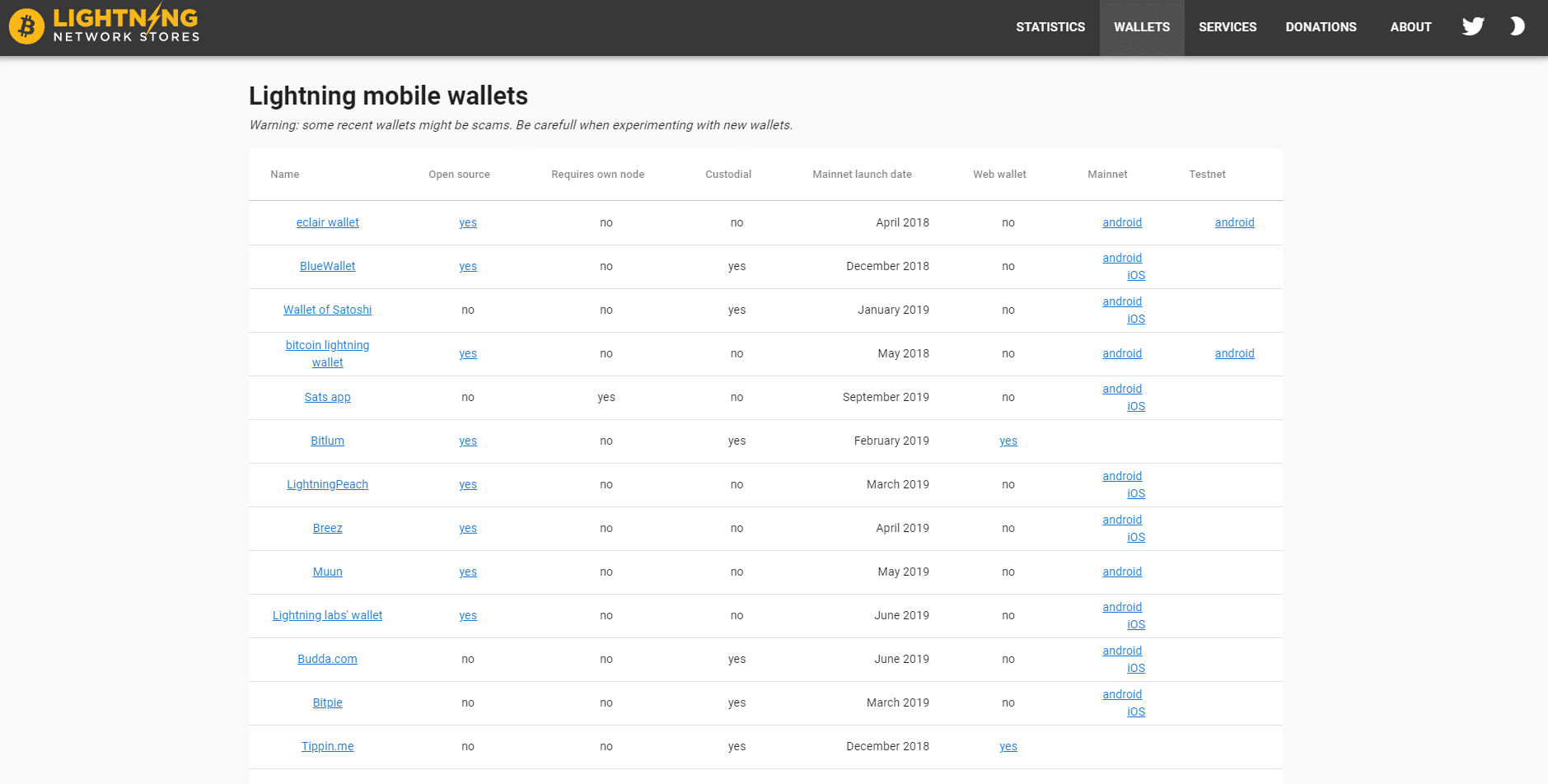Lightning Network is the second layer of bitcoin, a complex solution that should help scalability of BTC. Since the debut of the testnet in late 2017, several Lightning Network bitcoin wallets for Android and iOS mobile devices have been made available.
In the last two years, dozens of Lightning Network bitcoin wallets have been released, both for PC, Mac and Linux and for Android and iOS-based mobile devices.
Also, recently some web wallets have been appearing, even if they are often custodial-wallets, which means that they do not allow to have full possession and control of the private keys.
This list will briefly analyse the main Lightning Network bitcoin wallets for the mobile world, so for Android and iOS smartphones.
Several resources are available online that gather the main available wallets, including the following list, which includes the most popular solutions.

On such a website, in addition to the names of the wallets with links to the official websites, there is also an indication of whether or not they are open source projects (with links to the GitHub repositories).
It also shows whether a full proprietary Lightning Network node is required for operation or not, whether the applications have already been released and whether a version is available for the Mainnet or only for the Testnet.
and be sure to have full control over their own funds. Obviously, there are also download links, both for Android and iOS devices.
Lightning Network bitcoin wallet for mobile: the main solutions
Eclair Wallet
The most famous is definitely Eclair Wallet, available only for Android devices at the moment. It was the first Lightning Network bitcoin wallet which debuted in March 2018 on mobile devices. It can be downloaded from Google’s Play Store. It is available for both the mainnet and the testnet.
It is a classic bitcoin wallet based on the Eclair release to which the Lightning Network support has been added for making payments. By default, the wallet is only suitable for making payments, but by scrolling through the settings it is also possible to receive payments via LN.
In this case, as indicated by the app, it is mandatory to connect the smartphone and synchronise the wallet at least once every 10 days, for a maximum of two weeks. This is to ensure compliance with the block times and status updates provided by the Lightning Network protocol.
The wallet integrates the part relating to channel management, to the closing and opening, as well as for payment, and a whole series of additional features for expert users. The interface is very attractive and neat. It is obviously completely open-source and does not require a proprietary node to work. However, this means that the wallet itself operates as a client connected to a remote node.
Bitcoin Lightning Network
This is a very interesting wallet for Android smartphones since, unlike Eclair, it is not a simple client that connects to a remote node, but integrates a real SPV bitcoin node designed for Lightning Network. It can be downloaded from the Play Store at the following link.
It does not have an appealing interface like Eclair, but it is more comprehensive than the latter and offers everything necessary to receive and make payments using Lightning Network. Like Eclair, it is also completely open-source and non-custodial.
Zap Wallet
Moving on to the wallets for iOS devices, one of the most popular solutions is certainly Zap Wallet, available in beta version from the Apple Store for Apple smartphones and on the Google Play Store for Android smartphones.
Unlike the others, in order to work, Zap Wallet requires a local proprietary node running on its own device which is permanently connected to the network. In essence, therefore, it is a client that has to be connected to its own Lightning Network node running on a device that is constantly connected to the network.
Zap allows making and receiving payments using Lightning Network. For the operation, installation and creation of a Lightning Network node, it is possible to consult the official page of Zap Wallet. Zap is completely Open Source and Non-Custodial.
Blue Wallet
This is a wallet available for both iOS and Android devices. Unlike the solutions seen so far, it is an open-source custodial wallet, which means that the user does not have access to the private keys.
It can be downloaded from the Google Play Store for Android devices and from the Apple Store for iOS devices. Moreover, for iOS users, there is also the possibility to use Blue Wallet directly from Apple Watch, as the special mobile application is able to turn the Apple smartwatch into a real wallet extension to receive payments quickly.
Breez & Lightning Peach
These are two Lightning Network bitcoin wallets available for both iOS and Android mobile devices, both of which have very similar features. They are completely open-source, non-custodial and do not need any proprietary LN node to work.
As a matter of fact, Peach, during the wallet creation phase, explains step by step to the user how to create a proprietary LN node using Google’s free cloud service. It also offers the ability to connect to a personal node or a node of choice, giving the user the utmost degree of control.
By contrast, Breez offers an interesting solution alongside its LN wallet. The startup, in fact, intends to create a credit card that can take advantage of the LN wallet to make payments. In this way, users will be able to spend their bitcoins on daily purchases while minimising the costs, since LN transactions have almost no fees.
For more details, please visit the Breez and Peach websites.
Lightning Labs Wallet
Obviously, we couldn’t forget the wallet of Lightning Labs, announced last June 2019 and currently undergoing beta testing, both for iOS and Android devices.
It’s, of course, an open-source and non-custodial wallet, able to connect both to its own LN node as well as to a series of trusted nodes.
For all the details please consult the official website.



